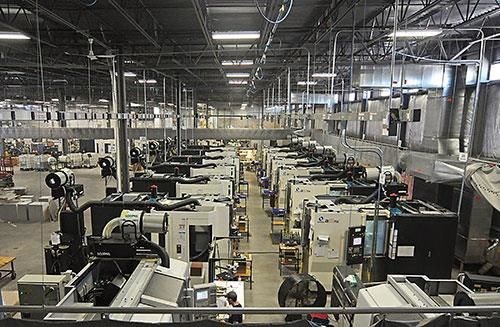The Decision Not to Automate Fully
Robotic automation for this machining line was feasible, but the company chose to run it 24/7 with a staff hired just for this job.
Share





Pointe Precision's move into long-running, high-volume production was a bold decision. Best known for low-volume, high-complexity aerospace and medical parts, this shop in Plover, Wisconsin, seized the opportunity to diversify its operations by becoming a major supplier of critical parts to a well-known manufacturer of recreational products. When the demand for these products soared, the manufacturer turned to Pointe Precision to duplicate its original, maxed-out production line to keep up with sales.
Buying and installing several Makino a51nx HMCs at a time, Pointe Precision eventually had 32 of these machines arranged in cells dedicated to this family of stainless steel parts. "Very early, we decided not to invest in automation, although a pallet delivery system with robots would have been feasible," says company owner Joe Kinsella.
His reasons not to automate were clear:
- Automation would have added to the cost and complexity of the system.
- It would have been difficult to grow the automation as more machines were added, especially since the final configuration of the cells hinged on an expansion to the existing shop building.
- A customized, dedicated system of automation would restrict the flexibility of the line, a key factor if the machines needed to be repurposed if and when the current status of this job changed.
Mr. Kinsella’s reasons to develop a workforce of specially trained hires to staff this line were equally clear:
- The size of the staff could be flexed as the production line grew.
- Suitable candidates for these positions were available in the central Wisconsin area, although special training would be needed.
- With proper training, people can be the most flexible and capable asset in a production setting.
- Creating jobs in manufacturing is a good thing for the community.
However, careful planning, the right level of on-machine automation and numerous accommodations to ensure the productivity and reliability of the strategy where required for success. You can read the full story here.
Related Content
-
Lean Approach to Automated Machine Tending Delivers Quicker Paths to Success
Almost any shop can automate at least some of its production, even in low-volume, high-mix applications. The key to getting started is finding the simplest solutions that fit your requirements. It helps to work with an automation partner that understands your needs.
-
Grob Robot Cell Enables Long Periods of Unmanned Operation
The GRC-R12 robot cell features a pneumatic single- or double-gripper system, as well as a drawer feed system with six drawers.
-
Large-Format Machining Simplifies Tube Manufacturing
Downtime is the enemy of efficient manufacturing — a problem FIBA Technologies has addressed through purchasing a Soraluce FLP 14000.























.jpg;maxWidth=300;quality=90)

.jpg;maxWidth=970;quality=90)